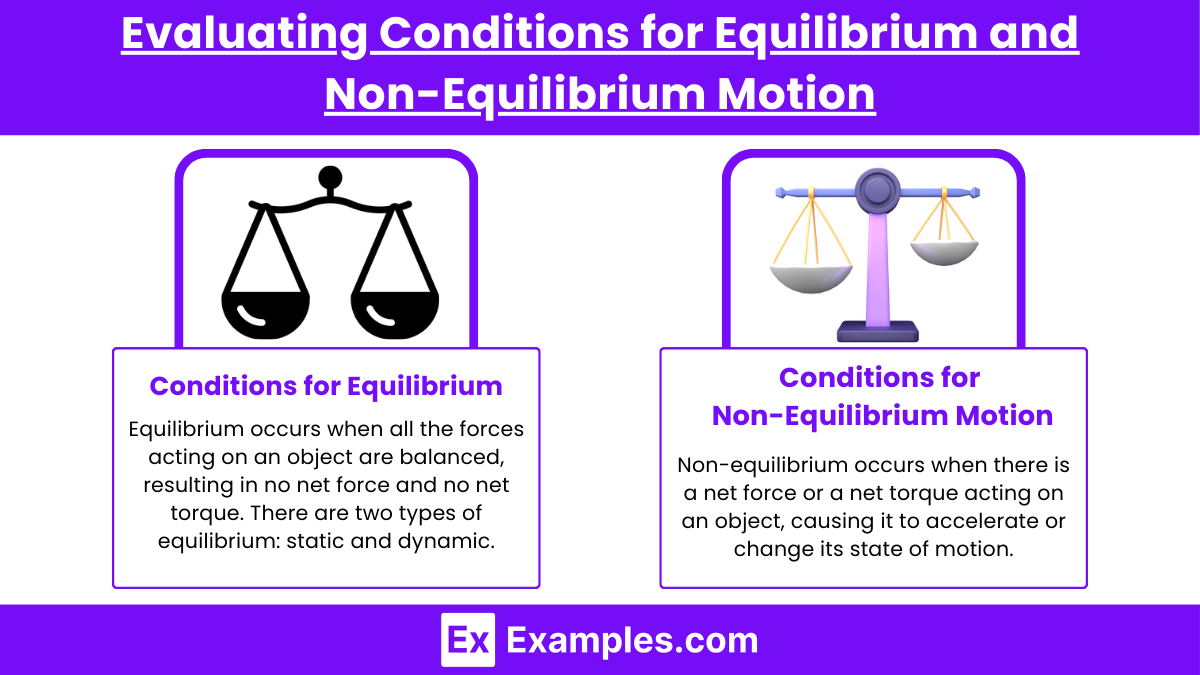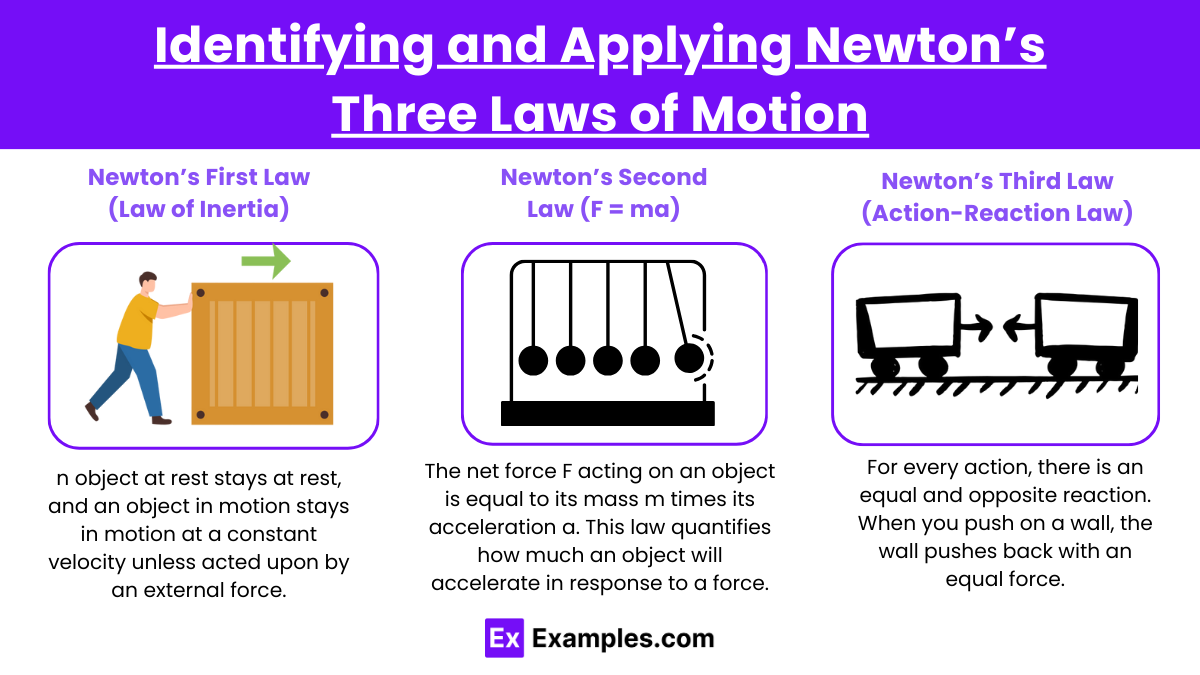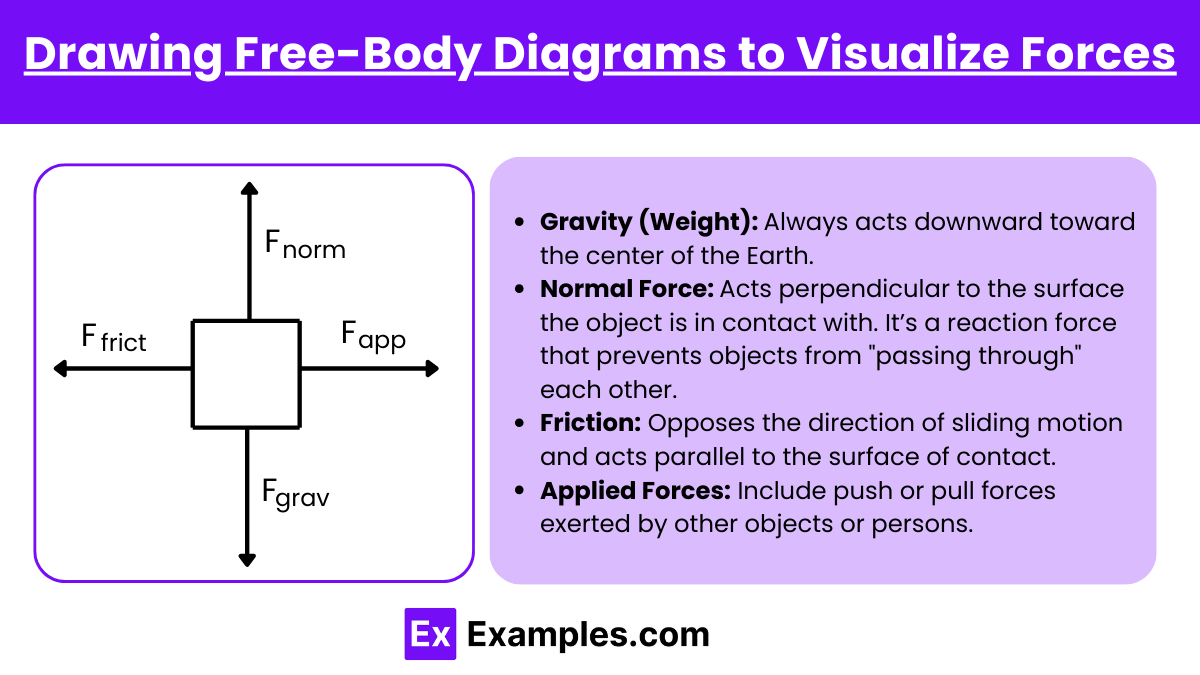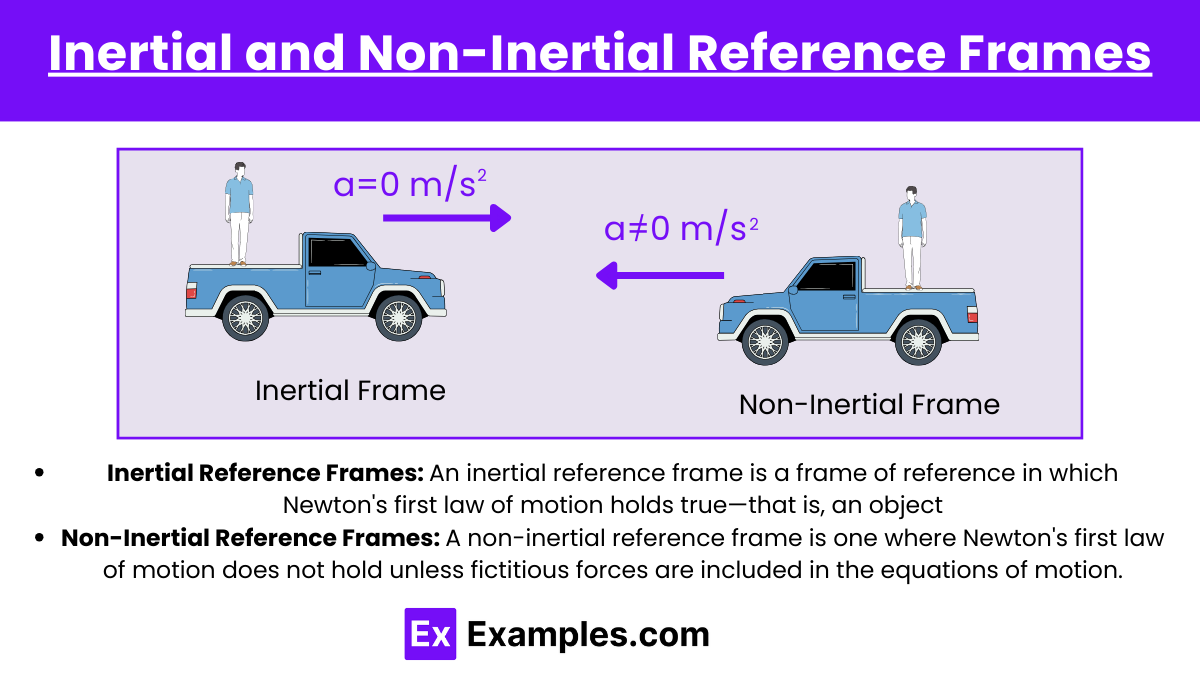Force and Newton’s laws of motion are fundamental to understanding the mechanics of physical systems, governing how objects interact and move. On the MCAT, you’ll explore the classifications of forces, applications of Newton’s three laws, and concepts like inertia, acceleration, and friction. Mastering free-body diagrams, gravitational forces, and the relationship between force and motion is essential, as these topics are crucial for excelling in the physics and mechanics sections of the exam.C) Both gravitational force downward and normal force upward.
Learning Objectives
In studying "Force and Newton's Laws of Motion" for the MCAT, you should learn to identify and apply the three laws of motion to describe how forces affect the movement of objects. Understand the concept of net force and how it relates to acceleration using F = ma. Analyze various forces such as gravitational force, friction, tension, and normal force in real-world scenarios. Practice drawing free-body diagrams to visualize forces acting on objects. Evaluate the conditions for equilibrium and non-equilibrium motion by applying Newton's laws to solve problems involving multiple forces. Additionally, understand the distinction between inertial and non-inertial reference frames and how fictitious forces arise in non-inertial frames.
Identifying and Applying Newton’s Three Laws of Motion
Newton’s First Law (Law of Inertia): An object at rest stays at rest, and an object in motion stays in motion at a constant velocity unless acted upon by an external force.
Explains why a moving car will continue moving unless brakes are applied or friction slows it down.
Newton’s Second Law (F = ma): The net force F acting on an object is equal to its mass m times its acceleration a. This law quantifies how much an object will accelerate in response to a force.
A 10 kg object experiencing a force of 20 N will accelerate at a = 2 m/s2.
Newton’s Third Law (Action-Reaction Law): For every action, there is an equal and opposite reaction.
When you push on a wall, the wall pushes back with an equal force.
Drawing Free-Body Diagrams to Visualize Forces
Identify the Object of Interest: Choose the object or body for which you are analyzing the forces. This object is isolated from its surroundings to simplify the analysis.
Sketch the Object: Draw a simple outline or a dot to represent the object in question. The diagram should focus on clarity and simplicity to effectively communicate the forces.
Represent Forces with Arrows: Draw arrows starting from the center or edge of the object, pointing in the direction in which each force is acting. Each arrow should be labeled to identify the type of force it represents. The length of the arrow can indicate the relative magnitude of the force.
Types of Forces to Consider:
Gravity (Weight): Always acts downward toward the center of the Earth.
Normal Force: Acts perpendicular to the surface the object is in contact with. It’s a reaction force that prevents objects from "passing through" each other.
Friction: Opposes the direction of sliding motion and acts parallel to the surface of contact.
Tension: Acts along the length of a rope or string, pulling equally on the objects it is attached to.
Applied Forces: Include push or pull forces exerted by other objects or persons.
Air Resistance: Acts in the opposite direction to the motion, similar to friction but through air.
Add Additional Elements if Necessary: If the object is on an inclined plane, represent the plane and angle. You might need to resolve forces into components parallel and perpendicular to the plane. For moving objects, consider adding motion direction or velocity vectors.
Check for Equilibrium or Motion Conditions:
Equilibrium: If the object is stationary or moving with constant velocity, the forces should balance out. This means the vector sum of all forces should equal zero.
Acceleration: If the object is accelerating, the net force in the direction of acceleration should not be zero.
Evaluating Conditions for Equilibrium and Non-Equilibrium Motion

Conditions for Equilibrium
Equilibrium occurs when all the forces acting on an object are balanced, resulting in no net force and no net torque. There are two types of equilibrium: static and dynamic.
Static Equilibrium: An object is in static equilibrium when it is at rest and remains at rest. The conditions for static equilibrium are:
Net Force is Zero: The vector sum of all forces acting on the object must be zero.
∑F = 0
This implies that the sum of the forces in each direction (horizontal and vertical) must also be zero:
∑Fx = 0, ∑Fy = 0
Net Torque is Zero: The sum of all torques about any point must also be zero. This ensures the object does not start rotating. ∑τ = 0 is calculated as the product of the force and the lever arm (the perpendicular distance from the pivot point to the line of action of the force).
Dynamic Equilibrium: An object is in dynamic equilibrium when it moves with constant velocity (including zero velocity). This also means that the net force and net torque are zero, similar to static equilibrium, but the object may still be in motion.
Conditions for Non-Equilibrium Motion
Non-equilibrium occurs when there is a net force or a net torque acting on an object, causing it to accelerate or change its state of motion.
Net Force is Non-Zero: If the sum of all forces acting on an object is not zero, the object will accelerate in the direction of the net force, according to Newton's second law:
∑F = ma, where m is the mass of the object and a is its acceleration.
Net Torque is Non-Zero: If the sum of all torques acting on an object about any axis is not zero, the object will start rotating or change its rotational motion.∑τ = Iα where I is the moment of inertia of the object and α is the angular acceleration.
Analyzing Equilibrium and Non-Equilibrium Examples
To practically evaluate these conditions, you can use free-body diagrams to visualize and calculate the forces and torques:
Inertial and Non-Inertial Reference Frames
Inertial Force, and Inertial Reference Frames
An inertial reference frame is a frame of reference in which Newton's first law of motion holds true—that is, an object either remains at rest or continues to move at a constant velocity, unless acted upon by a net external force. Essentially, in an inertial frame, there are no unexplained forces acting on the bodies within the frame.
Characteristics:
Newton's Laws Valid: All three of Newton's laws of motion are applicable in their simplest forms.
No Fictitious Forces: Objects do not experience fictitious forces (like centrifugal force or Coriolis force) that are apparent in non-inertial frames.
Examples: An ideal inertial frame can be considered as either at rest or moving with a constant velocity. For practical purposes, the Earth can often be considered an inertial frame for experiments and calculations that don’t require extreme precision.
Non-Inertial Reference Frames
A non-inertial reference frame is one where Newton's first law of motion does not hold unless fictitious forces are included in the equations of motion. These frames are accelerating with respect to inertial frames, either linearly or rotationally.
Characteristics:
Acceleration: These frames are either accelerating or rotating.
Presence of Fictitious Forces: To explain the motion of objects within these frames using Newton’s laws, fictitious forces must be introduced. These forces arise not from physical interactions but from the acceleration of the reference frame itself.
Centrifugal Force: Appears to act outward on all masses when the frame rotates.
Coriolis Force: Appears in rotating frames and acts perpendicular to the velocity of the moving object within the frame.
Examples: A rotating merry-go-round, a car accelerating or braking, or Earth when considering weather patterns and ocean currents (due to its rotation).
Distinguishing Between the Frames
To determine whether a reference frame is inertial or non-inertial, consider the presence of unexplained accelerations:
Check for Constant Velocity: If every object not under the influence of apparent forces maintains a constant velocity, the frame is likely inertial.
Identify Fictitious Forces: If you need to introduce fictitious forces to explain observations (like objects moving in curves when no real force appears to act on them), the frame is non-inertial.
Examples
Example 1: Falling Objects
When an object, like an apple, falls from a tree, it accelerates downward due to the force of gravity. According to Newton's second law, the force acting on the apple is equal to its mass multiplied by the acceleration due to gravity. As the apple falls, it gains speed until it hits the ground, illustrating how gravitational force influences motion.
Example 2: A Car Accelerating
When a car accelerates from a stoplight, the engine generates a force that propels the car forward. According to Newton's second law, the acceleration of the car is determined by the net force produced by the engine divided by the car's mass. If the driver presses the accelerator harder, the increased force leads to a greater acceleration, demonstrating how force affects motion.
Example 3: Pushing a Box
If you push a box across a floor, the force you exert on the box causes it to move. According to Newton's first law, an object at rest remains at rest unless acted upon by an external force. In this case, your push is the external force that overcomes the box's inertia, causing it to accelerate in the direction of the applied force.
Example 4: Sitting on a Chair
When you sit on a chair, your body exerts a downward force due to gravity, while the chair exerts an equal and opposite force upward, as described by Newton's third law of motion. This interaction illustrates the principle of action and reaction, where the forces acting on you and the chair are equal in magnitude but opposite in direction, allowing you to remain seated without falling through.
Example 5: A Rolling Ball
When you roll a ball across the ground, it eventually comes to a stop due to friction, which is a force that opposes the ball's motion. According to Newton's first law, the ball would continue moving in a straight line at a constant speed if no net external forces acted on it. However, friction acts as an unbalanced force, gradually slowing the ball down and bringing it to a halt.
Practice Questions
Question 1
A hockey puck slides on a frictionless ice surface. Which of the following statements is true regarding the puck's motion?
A) The puck will eventually stop due to friction.
B) The puck continues moving in a straight line at a constant speed.
C) The puck accelerates as it slides on the ice.
D) An external force is needed to keep the puck moving.
Correct Answer: B) The puck continues moving in a straight line at a constant speed.
Explanation: According to Newton's first law of motion, an object in motion will remain in motion with the same speed and in the same direction unless acted upon by an external force. Since the ice surface is frictionless, there are no significant forces acting on the puck to slow it down or change its direction, allowing it to maintain a constant velocity. Therefore, option B is correct, while options A, C, and D are incorrect.
Question 2
When a person jumps off a small boat onto the dock, the boat moves backward. Which law of motion explains this phenomenon?
A) Newton's first law
B) Newton's second law
C) Newton's third law
D) The law of universal gravitation
Correct Answer: C) Newton's third law.
Explanation: Newton's third law states that for every action, there is an equal and opposite reaction. When the person jumps forward off the boat, the action of pushing off the boat results in the boat moving backward as a reaction. This illustrates how forces are paired, leading to the boat's movement in the opposite direction. Thus, option C is correct, while options A and B do not apply in this scenario, and option D is unrelated to the action-reaction pair described.
Question 3
A 10 kg box is at rest on a horizontal surface. Which of the following forces acts on the box?
A) Only the gravitational force downward.
B) Only the normal force upward.
C) Both gravitational force downward and normal force upward.
D) There are no forces acting on the box.
Correct Answer: C) Both gravitational force downward and normal force upward.
Explanation: When the box is at rest on a horizontal surface, two forces are acting on it. The gravitational force pulls the box downward toward the Earth, while the normal force from the surface pushes upward against the box. These two forces are equal in magnitude and opposite in direction, resulting in a net force of zero, which keeps the box at rest. Therefore, option C is correct, while options A and B only describe one of the forces, and option D is incorrect as forces are indeed acting on the box.





